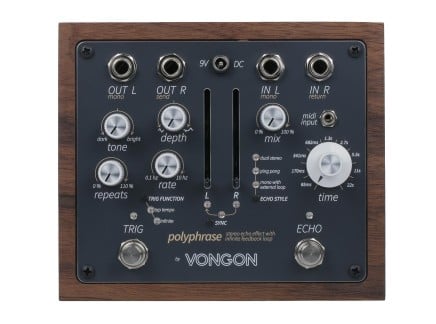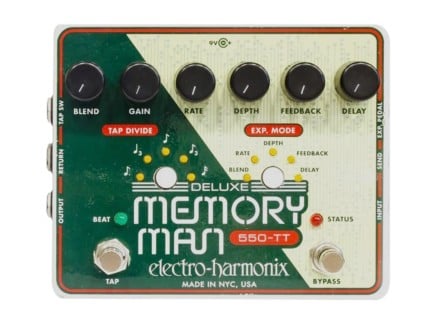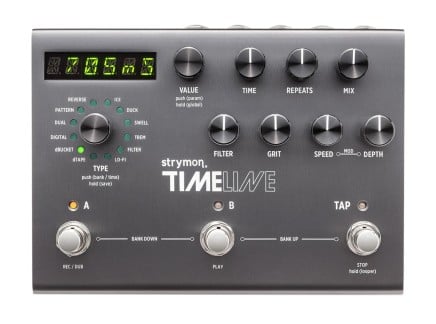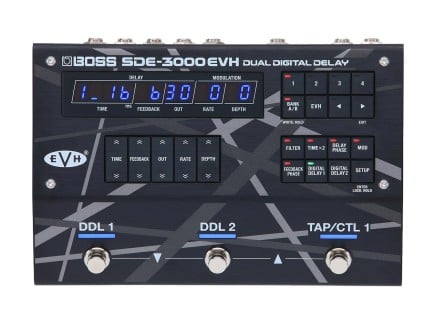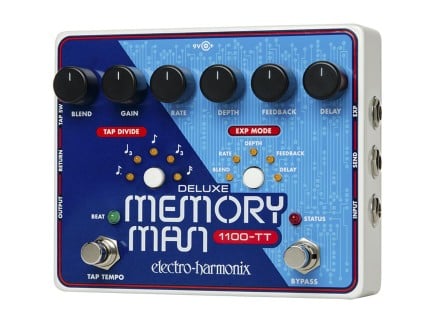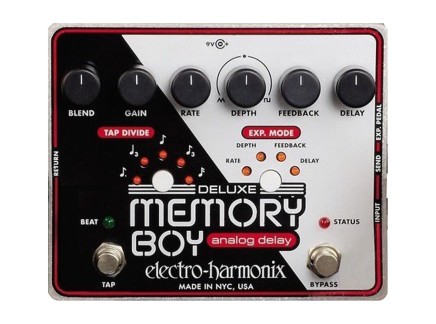Delay is one of the most common and most intricate guitar effects. Delay pedals range from supremely simple to confusingly complex and everything in between. On some level, you can think of delays as a whole as being split into two categories: digital and analog. Both offer their own distinct sounds.
Analog delays are usually pretty simple, with a few controls to set their vibey vintage sound. Some come with modulation, like the Electro-Harmonix Memory Man or Dunlop EP103 Echoplex. But overall, most analog delays are designed to be streamlined. Generally, analog delay pedals are more about the character of the sound.
Digital delays are often quite different. They run the gamut in terms of features and functionality, but generally speaking, they are much more versatile than most of their analog counterparts. Some offer a more efficient feature set that’s easy to dial in quickly, like the BOSS DD-8. But many digital delays offer an incredible range of sounds, controls, and next-generation features that turn them into an entire sound workstation.
One interesting and experimental feature that can come along with analog or delay pedals, though, is the external feedback loop. An external feedback loop enables you to add other effects into the delay line's feedback path—creating echoes that gradually change in tonal character, with each repeat different from the one before it. This can be suble or extreme, but one thing is certain: it opens up your sound options exponentially.
Before we get into the dirty details of what an external feedback loop is, let’s refresh ourselves on how delays work in general.
How Delay Effects Work
Delay pedals are one of the most common types of guitar effects, but many may not fully understand how they work under the hood. There are multiple types of delays that all function under a similar concept, but produce their own unique sounds.
Analog and tape delays have a more lo-fi quality and usually offer less versatility, but there’s no disputing the warm, vintage sounds they impart. Digital delays are often a little “colder,” but are much more flexible. Then, there are more esoteric extensions of digital delay techniques, like reverse (which plays the signal backwards), or shimmer (which adds octave up pitch shifting to the signal).
Conceptually, though, the way that analog and digital delays work is quite similar. Delay effects take the signal that’s fed into them, store it to a data storage medium (like analog tape, a bucket brigade chip, or digital memory). It then plays the sound back at a later time, creating an echo-like effect. Almost every delay out there will offer a control for delay time—the amount of time between the input and the repeat. Many delays also offer an output level control, or a wet/dry mix to blend between your dry and processed signal.
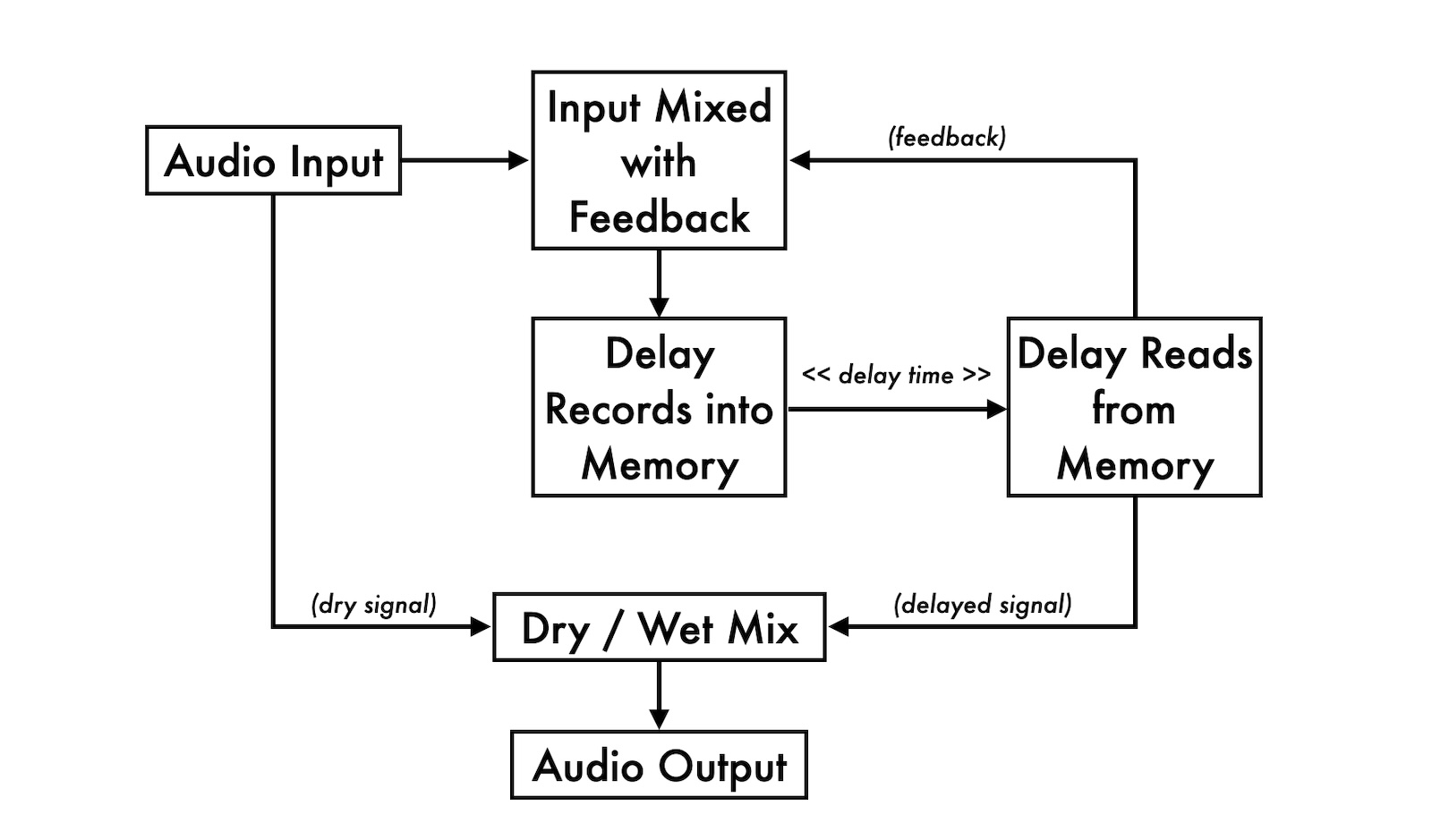
[Above: simple diagram detailing the inner workings of a delay effect.]
But the other most common parameter on a delay pedal is the feedback control (sometimes referred to as "regeneration" or "repeats"). This control ultimately determines the number of repeats you hear after the initial echo: at zero feedback, you'll only hear one repeat, and at higher levels, you'll hear many repeats that gradually decay to silence. On some delays, extreme feedback settings will result in echoes that gradually increase in volume, until you hear nothing but a sustained wash of wailing noise (nice).
But before we dive into the main topic—how you can use external feedback loops—we first need to establish a better understanding of how feedback works in delay effects altogether.
How Does Delay Feedback Work?
Feedback in the context of delay pedals is the process of feeding the circuit's output signal back into the circuit's audio input—right alongside your input signal. You can think of the feedback knob on a delay as a sort of "volume control" that gradually introduces more and more of the delay's own output back into its input.
But you might be wondering…aren't feedback loops a bad thing? It's true—in certain circumstances, like in live sound reinforcement, feedback is undesirable. It can result in distortion, unwanted accentuation of specific resonant frequencies, or even all-out bursts of ear-piercing noise. But controlled feedback in the context of audio effects can actually be quite handy—in fact, feedback loops are a common and important feature of everything from flangers and phasers to, of course, delays.
If you think it through, this makes a lot of sense…and it explains how delays can be used for repetitive echo effects. Each echo itself gets sent back through the echo process, and echoed again and again until it decays to silence.
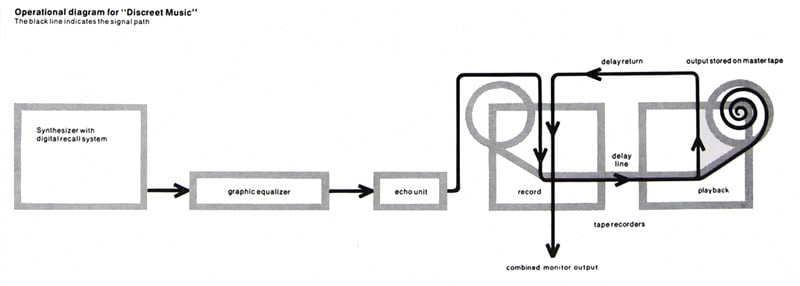
[Above: signal flow diagram from Brian Eno's Discreet Music, describing some of the tape delay/feedback processes used to create the album.]
In fact, this idea evolved out of old tape delay techniques, where multiple tape players would be connected together using the same tape loop. One would be set to record while the other played the tape, and the "input" sound and the output of the "playback" tape machine would be mixed together and fed into the "record" tape machine's input. This resulted in audible repeats, with timing dependent on the length of the tape and the amount of space between the tape machines. There were many variations on this idea, with many different names—including early looping techniques like Terry Riley's "time lag accumulation" or Eno/Fripp's "Frippertronics."
Today, analog delay effects are usually implemented with bucket-brigade chips, or BBDs. A BBD is an analog circuit built into a chip, and is one of the original ways that guitar delay effects moved from the bulky, cumbersome tape units into smaller format pedal enclosures. Eventually, of course, digital data storage and recall techniques further advanced the state of the art.
With most delay designs, if a guitar player wants to add additional effects with the delay sound they had to put them before or after the delay. This factors into how they have their signal routed and their pedalboard set up. But delays with external feedback loop options—admittedly not altogether a common feature—present unique tone-shaping opportunities.
What is an External Feedback Loop in Delay Pedals?
You won’t find one on every delay pedal, but external feedback loops are a feature that’s growing in popularity. They provide a separate channel to send the output of the delay signal back around to the input.
With an external feedback loop, effects can be placed between the output and input sections of the delay within the pedal's feedback path. It's sort of an insert point in the delay feedback path, exposing a part of the circuit that is ordinarily closed.
Think of it like this: remember that tape loop description above? If we add an effect like a filter after the final output, each repeat will be equally filtered; if we add a pitch shifter, for instance, each repeat will be pitch shifted by the same amount. But what if you added a filter between the "playback" tape machine and the "record" tape machine? Each "echo" would be gradually filtered more and more. What if you added a pitch shifter? Each "echo" would be gradually more and more pitch shifted. The concept is the same: on a delay pedal, an external feedback loop is inserted between the pedal's output and the "feedback" level control.

[Above: a digram detailing how to connect a pitch shifter in a delay's feedback loop for progressively pitch-shifted repeats.]
By adding extra effects at this point in the signal path, you impart changes that progressively alter the tonal character of the delay one repeat at a time, rather than affecting all the repeats equally. This opens up entirely new worlds of sounds in ways that aren’t otherwise possible.
Analog and digital delays may offer this feature. As one of the most popular analog delays of all time, the effects maestros at Electro-Harmonix have updated their offerings like the Deluxe Memory Man TT and Deluxe Memory Boy to provide classic analog delay sounds with more modern features like an external feedback loop. While this feature is also relatively uncommon in digital delays, some stereo digital delays offer a mode where you can repurpose one output and one input as the "send" and "return" of an external feedback loop, respectively. The Strymon Timeline and Vongon Polyphrase are two such examples (and excellent examples, at that).
With an external feedback loop you get more control over how intense the feedback gets than the standard feedback control that many delays offer can give you. The feedback becomes more organic and evolving, and allows you to craft ambient sounds and textures. But remember, high feedback settings come with risk—they can become hard to control and amplify the sound in unpleasant ways, especially when the additional effects in the feedback loop have the capacity to alter your signal's overall gain or to accentuate specific frequencies. It’s best to start at lower feedback settings and gradually increase the settings as you chase the tones you’re looking for.
Using Effects in a Delay Feedback Loop
By using guitar pedals as insert effects in a delay pedal’s external feedback loop can open up entirely new worlds of sound opportunities and access sounds that wouldn’t be possible otherwise. Let's talk through the implications of this type of processing with different effects.
Filters
By using filters in the feedback loop you, can tailor the EQ profile of your delay sounds. A lot of delays offer some level of control over the equalization, even if it’s just a tone knob. But by adding an EQ pedal into the mix you can really customize the equalization profile.
Filters are one of the more common and practical tools to add into a delay pedal's feedback loop: one of the most useful ways to use filter or EQ is to cut out mud from gradually accumulating delay feedback. As buildup occurs with each repetition things can get out of control, and many times the right EQ moves are the answer: creating echoes that lose energy in problematic frequency ranges with each repeat.
Think of it this way: a highpass filter in a delay's feedback loop will result in echoes that get gradually thinner over time, creating room for other sounds in the low end. Adding a lowpass filter in a delay's feedback loop will cause repeats to get darker over time, making room in the upper register so that higher tones don't need to "compete" with the echoes.
Modulation
Modulation effects are one of the most common that are paired with delay pedals, as they add depth and movement to delay sounds. A lot of delay pedals, like the Electro-Harmonix Memory Man and MXR Carbon Copy offer onboard modulation for this very reason.
Adding modulation to delay creates differentiation with each repetition. The main types of modulation pedals—chorus, phase, and flange—all use an element of delay in their design, so it makes sense that they work well together.
Adding modulation within a delay pedal's feedback path is similar to adding modulation after the delay, but instead of adding a uniform texture to the sound, it causes the modulation effect to vary in depth with each repeat. What this means can vary: it can cause your repeats to gradually devolve into a swarming chorus soup; alternatively, it could mean that different frequency ranges get accentuated with each repeat, creating echoes that change in spectral focus, with certain frequency ranges decaying while others build up, or vice versa. There's a lot of potential for creative experimentation here.
Reverb
Reverb effects are designed to simulate the way that sound interacts within a specific type of acoustic space. And since it’s a time-based effect just like delay, the two pair very well together.
The reverb gives depth and dimension to the delay sound and can make guitar tone sound absolutely huge. Adding reverb into a delay's feedback path can also serve to accentuate different tones within the reverb's own decay tails, and may cause the reverb to seem to self-oscillate at time, turning it into an instrument all its own. Try varying the reverb decay time and delay time to explore these textures, and trying thinking of the reverb more as a resonator than as a space—this might lead you to interesting creative results.
Pitch Shifters
Pitch shifters add an ethereal element to delay sounds. Octave-up pitch shifting is a main component of the “shimmer” effect, which depends heavily on the sound of echoes that cascade upward by an octave with each repeat. It's also common to add a fifth-up pitch shift effect into a delay's feedback loop for some lush, quintal harmony—or to add a major second up or down shift for mysterious, sci-fi whole-tone harmonies. But going up in pitch is far from the only way pitch shifters complement delay. Going up by a minor third introduces fully diminished seventh chord harmonies; going up by a major third creates augmented triads.
The longer the delay time, the more space between the shifted pitches. Short delay times will result in harmonization-like effects, while longer delay times will sound more like an arpeggio. If you get good at working with this trick, you can even create complex rhythmic lines that depend on the interplay between your live and shifted sounds. (For instance, this is a common trick employed by experimental guitarist and effect enthusiast Nick Reinhart. In the bridge of the Tera Melos track "Trash Generator," Reinhart uses a Source Audio Nemeis delay to create a peculiar counterpoint between his live guitar and a single pitch-shifted repeat.)
It’s one thing to add a static pitch shift, but just think about the possibilities if you use a more performative real-time shift effect…or, what if you used a ring modulator or frequency shifter instead of a true pitch shifter? The results can be downright wild.
Also, note that pitch-shifted delays have sort of become their own entity altogether—pedals like the Red Panda Raster 2, the aforementioned Source Audio Nemesis, the EarthQuaker Devices Rainbow Machine, and others all take advantage of this specific trick without the need for an external feedback loop, by coupling delay and pitch shifting internally. This is an old trick that has found various manifestations over the years, from tape studios to Eventide rack units and beyond.
Overdrive, Distortion, and Fuzz
Need to add some saturation, harmonics, or sustain? Then these types of gain pedals are the answer. Using them in a feedback loop probably won’t give you that “singing” guitar solo tone. But that’s not really the point. Depending on the settings you’ll get anything from crisp crunch to full on fuzzed out insanity.
When you stack it with other gain pedals not in the delay feedback loop…things start to get even more interesting.
Of course, keep in mind that altering the gain of the feedback signal is more or less synonymous with altering the intensity of the feedback—so your signal levels might start to get a little out of control. Be sure to balance the feedback knob on the delay as you make adjustments to your dirt pedal of choice.
Additional Delays
Not every delay pedal can do it all. That’s where stacking delays comes in. You can make the sound shift even more—and depending on which you’re using you might not have access to more unique delay sounds like reverse or shimmer.
Using more than one delay at once can get wild, creating unpredictable rhythms that shift and sputter as they evolve. But isn’t that part of the fun?
Esoteric Effects
There are too many types of effects to go over them all. But adding in more esoteric options like ring modulation, tremolo/panning, or the Electro-Harmonix 9 Series pedals make the sound possibilities almost limitless.
How to Hack it Together Yourself
Note: though most delay pedals don't offer an external feedback loop control, you can hack it together yourself even on a pedal that doesn't include one. Try this patch: send your sound source into a mixer (preferably one with multiple parallel outputs, though you can achieve this with a downstream signal splitter after the mixer's output as well). Send the mixer's output into your delay pedal; turn the delay pedal's feedback control down and send its output through your effect(s) of choice. Send the output of that effect chain back into another input on the mixer, and monitor the mixer's second output (or the splitter's output, if your mixer doesn't offer multiple parallel outputs).
Congratulations: you've just created an external feedback loop for your delay pedal. Rather than relying on the pedal's internal feedback loop, you can treat that second input on your mixer as a "feedback" control. Have fun!
Conclusion
External feedback loops in delay pedals are a very interesting feature, as they expand the options you have when you’re crafting sounds. One of the best elements of them is that you can make the insert processing as simple or complex as you like. The only rules are the ones you impose on yourself.
It will be interesting to see if more manufacturers start building them into their products, as the upside is almost limitless.
Brandon Stoner is a lifelong musician and audio engineer who owns more guitars than anyone needs. As a lover of all things writing and music technology, he crafts every piece with his dog Max on his lap.


